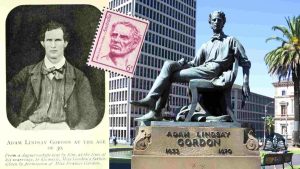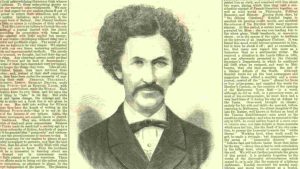Celebrated Poets from Australia
The ballads and poems of early Australian bush poets like Banjo Paterson really captured the spirit of the outback. While poets like Adam Lindsay Gordon wrote some great ballads, Paterson brought the bush to life in a way that resonated with Australians.
Influential Australian Poets
Australia has produced many esteemed poets over the years who have made significant contributions to the literary arts scene. Here are some iconic Australian poets known for their influential works:
Adam Lindsay Gordon

Adam Lindsay Gordon was born in 1833 in England to a wealthy British military family. As a student he was undisciplined and expelled from elite schools, so his father sent the troubled Gordon to Australia in 1853 to join the police force and start fresh. Gordon soon left the police to focus on horse racing and steeplechasing, gaining renown as a daring rider. He also began publishing poetry in the late 1850s. Gordon married in 1862 and continued his interests in horses and writing, even serving briefly in politics before returning to poetry. In 1870 he published his seminal work “Bush Ballads and Galloping Rhymes” which was praised for pioneering a distinctly Australian poetic style and bush poetry traditions. However, Gordon struggled with depression, debt, and fading prospects, eventually committing suicide in June 1870 at just 36 years old by shooting himself. Though his life was tragically short, Gordon was posthumously hailed as Australia’s ‘national poet’ who helped establish literary traditions drawing on the bush, frontier, and horses. He remains one of Australia’s most influential early poets, shaping the emerging national poetic identity through his iconic bush ballads, though his legacy has declined over time. Monuments dedicated to Gordon were erected across Australia in recognition of his literary impact.
Banjo Paterson
Paterson is best known for his ballad “Waltzing Matilda” and his poem “The Man from Snowy River” which capture the rugged spirit of Australia’s landscape and people. He was a leading figure in bush poetry.
Andrew Barton “Banjo” Paterson (1864-1941) was an acclaimed Australian writer and poet who helped define the emerging national identity through his iconic depictions of the bush and its archetypal characters. Growing up on rural properties, Paterson developed a deep love for the outback which shaped his writing. As a solicitor and journalist, he gained prominence in 1895 for ballads like “The Man from Snowy River” that romanticized the frontier spirit.
Paterson had an incredible gift for storytelling. His ballads like “The Man from Snowy River” and “The Bandit” transported readers right into the middle of an exciting adventure full of danger and drama. He made the characters and landscapes feel real through vivid descriptions.
What also made Paterson so relatable was his ability to capture the laconic Australian spirit – the courage, resilience and dry sense of humor Australians identified with. Lines like “for the bush will never suit you, and you’ll never suit the bush” summed up the hardships of outback living.
The bush ballads of Banjo Paterson captured the adventurous, humorous and stoic Aussie character. He brought the remote outback and its people right into Australian homes through his poetry. That’s why he became so beloved and why his poems like “Waltzing Matilda” are still so widely known today. Paterson made the bush part of Australia’s identity.
Paterson became Australia’s celebrated ‘bush poet’ with the runaway success of his first poetry collection and went on to have parallel careers in literature and journalism. He covered the Boer War as a foreign correspondent and served in World War I. Works like “Waltzing Matilda”, “The Man from Snowy River”, “Clancy of the Overflow” and “The Geebung Polo Club” made Paterson one of Australia’s most cherished writers for his lyrical capturing of the nation’s early ethos. Revered in his lifetime, he helped enshrine the outback ethos into Australian folklore.
Henry Lawson
Lawson was a contemporary of Paterson and also renowned for his works set in the Australian bush like “The Drover’s Wife” and “The Loaded Dog” that realistically depict life in the outback.
Henry Kendall

The poet Henry Kendall stands as one of the founding fathers of Australian literature. Though he struggled with poverty and illness throughout his short life, Kendall pioneered a uniquely Australian style of pastoral poetry. He brought the harsh beauty of the Australian wilderness to life through vivid images of gum trees, bell birds, rocky cliffs, and winding creeks. Kendall became renowned for lyrical poems like “Bell Birds” and “The Voice in the Native Oak” that capture the mystery of the bush. He contributed greatly to an emerging sense of national identity through his reverence for the native landscape. The rich sensory details and colloquial language of poems like “Araluen” and “Bill the Bullock Driver” transport readers straight into the world of the bushman. Kendall’s oeuvre, especially collections like “Leaves from Australian Forests” and “Songs from the Mountains,” deserve wider appreciation as foundational texts of Australian literature. Any reader interested in this nation’s cultural origins would do well to explore Kendall’s evocative visions of the bush.
Dorothea Mackellar
Mackellar gained fame for her iconic patriotic poem “My Country” which celebrates Australia’s lush greenery and sunburnt plains. She is remembered for nationalistic verse.
Judith Wright
Wright is considered one of Australia’s greatest modernist poets. She examined Australian history and aboriginal culture in her moving poem “Nigger’s Leap, New England.” She was an activist for the environment.
Gwen Harwood
Harwood’s work broke ground in Australian poetry by experimenting with forms like sonnets, villanelles and satire on suburban life. She tackled feminist themes in works like “In the Park.”
A.D. Hope
Hope helped establish Australian poetic identity through satirical works critiquing Platonic ideals and intellectualism like “Australia” and his humorous take on bush ballads.
Jennifer Rankin
Rankin was the first Aboriginal poet to have her work published in Australia. Her poems often deal with the mistreatment of indigenous people and nature.
Judith Rodriguez
Rodriguez is known for chronicling the immigrant experience of Australians displaced post World War II in her work. She examined identity and relationships.
Les Murray
Murray garnered acclaim for his distinct poetic voice celebrating Australian landscapes and colloquialisms. His poem “The Broadbean Sermon” exemplified his unique style.
These are just a few of the iconic poets who have shared the Australian experience through insightful, profound and socially relevant poetry over the decades. Their works have left an indelible mark on Australia’s literary arts.

